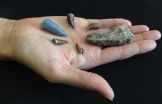(Press-News.org) Combination therapy with both BRAF inhibitor vemurafenib and MEK inhibitor cobimetinib achieves greater progression-free survival and response rates than vemurafenib plus placebo in BRAF-mutation positive melanoma, according to phase III data presented at the ESMO 2014 Congress in Madrid, Spain.
"Before the results of this study, we knew that cobimetinib plus vemurafenib could be safely delivered together with highly promising rates of tumour shrinkage; however until the performance of a scientifically rigorous randomised trial the potential magnitude of this benefit could not be measured," says lead author Dr Grant McArthur, head of the Cancer Therapeutics Program at the Peter MacCallum Cancer Centre, Melbourne, Australia.
The ongoing CoBRIM study enrolled 495 treatment-naive patients with BRAFV600-mutation-positive unresectable locally advanced or metastatic melanoma. Patients were randomised to received a 28-day treatment cycle of vemurafenib (960 mg, twice daily), and either cobimetinib or placebo (60 mg daily from days 1-21), with a primary end-point of progression-free survival.
Patients in the combination arm of the study showed a significantly improved median progression-free survival of 9.9 months, compared to 6.2 months in the placebo arm, and a 49% reduction in the risk of progression. Researchers observed a response rate of 68% in the combination arm and 45% in the control arm, including a complete response in 10% of patients treated with combination therapy compared to 4% of patients treated with vemurafenib alone.
"This study is very important as it shows that using drugs together to turn off two individual proteins (BRAF and MEK), that interact and bind to each other in the cell, gives much improved results for patients. This is fundamental concept that could have far reaching consequences for how we treat many cancers," says McArthur.
Combination therapy did lead to a greater number of grade 3 and above adverse events compared to vemurafenib alone, but treatment with cobimetinib plus vemurafenib also seemed to reduce the incidence of skin-related side-effects known to occur with vemurafenib.
In summary, McArthur says, "We anticipate that the combination of a BRAF and MEK inhibitor will become a new standard treatment for advanced BRAF-mutant melanoma. The data lay the foundation for the addition of treatments either in sequence or in further combination to obtain even better results."
Improved response rate and survival with dabrafenib plus trametinib versus vemurafenib alone
Targeting BRAF V600E/K mutation-positive melanoma with a combination of dabrafenib plus trametinib achieves longer overall survival and progression-free survival as well as better response rates, compared to treatment with vemurafenib alone, according to data from an open-label phase III trial, also presented at ESMO 2014 in Madrid.
"We knew from previous studies of dabrafenib plus trametinib that the response rates were higher than those observed with dabrafenib monotherapy and that the progression-free survival was also significantly longer," says lead author Dr Caroline Robert, head of Dermatology at the Institute Gustave Roussy, Paris, France.
The ongoing two-arm study has randomised 704 patients with advanced BRAF V600E/K mutation-positive melanoma either to a combination of dabrafenib (150 mg twice daily) plus trametinib (2 mg once daily), or to vemurafenib (960 mg, twice daily) alone. The primary endpoint is overall survival, with secondary endpoints of progression-free survival, objective response rate, duration of response, and safety.
A pre-planned interim analysis shows a 31% improvement in overall survival among patients on combination therapy, and a 44% reduction in the risk of disease progression compared to vemurafenib monotherapy. Researchers found a median progression-free survival of 11.4 months for dabrafenib plus trametinib, and 7.3 months for vemurafenib.
Patients in both arms of the study had similar rates of severe adverse events, although treatment with combination therapy was associated with a much lower rate of cutaneous squamous cell carcinoma.
In July this year, the study was stopped, and patients originally randomised to the vemurafenib arm of the trial were allowed to cross over to the combination arm.
In summary, Robert says, "These results further corroborate the early preclinical data that more complete blockade of the MAP kinase pathway delays the emergence of resistance, translating into longer survival for the patients."
Commenting on the results from these two studies, Dr Reinhard Dummer, from the University of Zurich Hospital, ESMO Faculty Coordinator for melanoma, says: "While monotherapy with a BRAF inhibitor is currently considered as a standard of care for patients with BRAF mutated advanced melanoma, the data from these two trials, along with trial data presented earlier this year, provide convincing evidence that combination therapy with either dabrafenib and trametinib, or vemurafenib and cobimetinib will be the standard systemic therapy for this patient population."
"The combination provides more efficacy concerning response rate and progression-free survival and overall survival documented for the trametinib and dabrafenib combination with a similar to lower load of adverse reactions," Dummer says.
"Of special relevance is the lower risk for new cutaneous malignancies which might be a surrogate for other secondary malignancies associated with the use of monotherapy BRAF inhibitors."
INFORMATION:
New data on combination treatments for melanoma
Vemurafenib + cobimetinib achieves significant progression-free survival and response rates in melanoma; Phase III trial data shows better outcomes with combination therapy than vemurafenib alone
2014-09-29
ELSE PRESS RELEASES FROM THIS DATE:
Studies report new findings on treatment options for mesothelioma
2014-09-29
Treating patients with high-dose radiotherapy after chemotherapy and surgery for malignant pleural mesothelioma does not achieve improvements in local relapse and overall survival, according to data from a prospective randomized phase II trial presented at ESMO 2014 Congress in Madrid.
"Mesothelioma remains a difficult disease to find better treatment options for, so we asked whether high-dose hemithoracic radiotherapy would decrease the rate or delay the time of local recurrence after chemotherapy and radical surgery," says lead author Prof Rolf A. Stahel, from the ...
Promising results shown with targeted approaches in subsets of non-small cell lung cancer
2014-09-29
The BRAF inhibitor dabrafenib has significant anti-tumour activity in patients with advanced BRAF V600E mutant non-small cell lung cancer whose disease has progressed after chemotherapy, according to phase II data presented at the ESMO 2014 Congress in Madrid, Spain.
"Reports of lung cancers bearing mutations in BRAF have generated considerable interest because these mutations may be associated with increased sensitivity to BRAF tyrosine-kinase inhibiting agents," says lead author Dr David Planchard, pulmonary oncologist at the Gustav-Roussy Cancer Campus, Paris, France. ...
Scientists make droplets move on their own
2014-09-29
Droplets are simple spheres of fluid, not normally considered capable of doing anything on their own. But now researchers have made droplets of alcohol move through water. In the future, such moving droplets may deliver medicines, etc.
To be able to move on your own – to be self-moving – is a feature normally seen in living organisms. But also non-living entities can be self-moving, report researchers from University of Southern Denmark and Institute of Chemical Technology in Prague, Czech Republic.
The researchers have made alcohol droplets move in a life-like way, ...
Avoid skunky beer this Oktoberfest with the help of chemistry
2014-09-29
WASHINGTON, Sept. 29, 2014 — Oktoberfest is here, and that means beer. And there's nothing worse than reaching for a cold one, taking that first sip and realizing your beer's been skunked: chemicals have reacted to form compounds that cause an awful, bitter taste. This week, Reactions explains why beers get skunky, and what you can do to keep your brews from going bad. Learn all about it at http://youtu.be/9i4dHdQzTFg.
INFORMATION:
Subscribe to the series at Reactions YouTube, and follow us on Twitter @ACSreactions to be the first to see our latest videos.
The American ...
Ancient human genome from southern Africa throws light on our origins
2014-09-29
What can DNA from the skeleton of a man who lived 2,330 years ago in the southernmost tip of Africa tell us about ourselves as humans? A great deal when his DNA profile is one of the 'earliest diverged' – oldest in genetic terms – found to-date in a region where modern humans are believed to have originated roughly 200,000 years ago.
The man's maternal DNA, or 'mitochondrial DNA', was sequenced to provide clues to early modern human prehistory and evolution. Mitochondrial DNA provided the first evidence that we all come from Africa, and helps us map a figurative genetic ...
DNA signature found in ice storm babies
2014-09-29
This news release is available in French. Montreal, September 29th, 2014 - The number of days an expectant mother was deprived of electricity during Quebec's Ice Storm (1998) predicts the epigenetic profile of her child, a new study finds.
Scientists from the Douglas Mental Health University Institute and McGill University have detected a distinctive 'signature' in the DNA of children born in the aftermath of the massive Quebec ice storm. Five months after the event, researchers recruited women who had been pregnant during the disaster and assessed their degrees of ...
Who are the men and boys suffering from anorexia?
2014-09-29
A new study by researchers from the University of Montreal reveals the current state of knowledge about anorexia in men and boys. "Most of the knowledge about anorexia pertains to females. However, about 10% of persons affected are males, and we believe this figure is underestimated," says Laurence Corbeil-Serre, lead author of the study. "Our results show that there appear to be similarities between the behavioural symptoms of males and females, but certain particularities can be identified in males, especially related to personality, gender identity, and sexual orientation."
The ...
Researchers show irradiation plus transplantation effective for treating HIV/AIDS
2014-09-29
Yerkes National Primate Research Center researchers are the first to show that an irradiation plus transplantation combination approach in nonhuman primates can be used to treat or even possibly cure HIV/AIDS, and this new model is providing some answers about the "Berlin patient," the only human thought cured of AIDS. The study is published in the September 25 issue of PLOS Pathogens.
Guido Silvestri, MD, division chief of Microbiology and Immunology at the Yerkes Research Center at Emory, and several of his research colleagues performed the first hematopoietic stem ...
Tooth buried in bone shows prehistoric predators tangled across land, sea
2014-09-29
About 210 million years ago when the supercontinent of Pangea was starting to break up and dog-sized dinosaurs were hiding from nearly everything, entirely different kinds of reptiles called phytosaurs and rauisuchids were at the top of the food chain.
It was widely believed the two top predators didn't interact much as the former was king of the water, and the latter ruled the land. But those ideas are changing, thanks largely to the contents of a single bone.
In a paper published online in September in the German journal Naturwissenschaften, Stephanie Drumheller of ...
Simulations reveal an unusual death for ancient stars
2014-09-29
Certain primordial stars—those 55,000 and 56,000 times the mass of our Sun, or solar masses—may have died unusually. In death, these objects—among the Universe's first-generation of stars—would have exploded as supernovae and burned completely, leaving no remnant black hole behind.
Astrophysicists at the University of California, Santa Cruz (UCSC) and the University of Minnesota came to this conclusion after running a number of supercomputer simulations at the Department of Energy's (DOE's) National Energy Research Scientific Computing Center (NERSC) and Minnesota Supercomputing ...
LAST 30 PRESS RELEASES:
Routine scans could detect early prostate radiotherapy changes
Fairness in AI: Study shows central role of human decision-making
Pandemic ‘beneath the surface’ has been quietly wiping out sea urchins around the world
Tea linked to stronger bones in older women, while coffee may pose risks
School feeding programs lead to modest but meaningful results
Researchers develop AI Tool to identify undiagnosed Alzheimer's cases while reducing disparities
Seaweed based carbon catalyst offers metal free solution for removing antibiotics from water
Simple organic additive supercharges UV treatment of “forever chemical” PFOA
£13m NHS bill for ‘mismanagement’ of menstrual bleeds
The Lancet Psychiatry: Slow tapering plus therapy most effective strategy for stopping antidepressants, finds major meta-analysis
Body image issues in adolescence linked to depression in adulthood
Child sexual exploitation and abuse online surges amid rapid tech change; new tool for preventing abuse unveiled for path forward
Dragon-slaying saints performed green-fingered medieval miracles, new study reveals
New research identifies shared genetic factors between addiction and educational attainment
Epilepsy can lead to earlier deaths in people with intellectual disabilities, study shows
Global study suggests the underlying problems of ECT patients are often ignored
Mapping ‘dark’ regions of the genome illuminates how cells respond to their environment
ECOG-ACRIN and Caris Life Sciences unveil first findings from a multi-year collaboration to advance AI-powered multimodal tools for breast cancer recurrence risk stratification
Satellite data helps UNM researchers map massive rupture of 2025 Myanmar earthquake
Twisting Spins: Florida State University researchers explore chemical boundaries to create new magnetic material
Mayo Clinic researchers find new hope for toughest myeloma through off-the-shelf immunotherapy
Cell-free DNA Could Detect Adverse Events from Immunotherapy
American College of Cardiology announces Fuster Prevention Forum
AAN issues new guideline for the management of functional seizures
Could GLP-1 drugs affect risk of epilepsy for people with diabetes?
New circoviruses discovered in pilot whales and orcas from the North Atlantic
Study finds increase in risk of binge drinking among 12th graders who use 2 or more cannabis products
New paper-based technology could transform cancer drug testing
Opioids: clarifying the concept of safe supply to save lives
New species of tiny pumpkin toadlet discovered in Brazil highlights need for conservation in the mountain forests of Serra do Quiriri
[Press-News.org] New data on combination treatments for melanomaVemurafenib + cobimetinib achieves significant progression-free survival and response rates in melanoma; Phase III trial data shows better outcomes with combination therapy than vemurafenib alone



